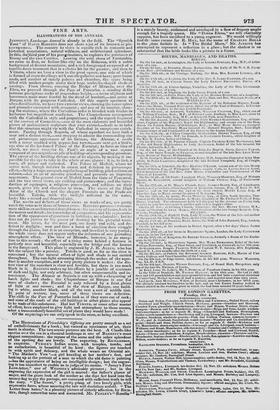FINE ARTS.
ILLUSTRATIONS OF THE ANNUALS.
JENNINGS'S Landscape Annual is already in the field. The "Spanish Tour" of DAVID ROBERTS does not abate a jot of its interest or picturesveness. The country he visits is equally rich in romantic and historical associations, natural wildness, and architectural splendour. In this, the:third year of his peregrinations, he explores the provinces of Biscay and the two Castiles. Leaving the wild shore of Fontarabia, we come to Irun, an Italian-like city on the Bidassoa, with a noble background of distant mountains, and a rich foreground composed of a tumble-down tenement that is a choice bit for the painter ; and then to Vittoria, where we have a view in the great square, one side of which is formed of crazy dwellings with outside galleries and heavy pent-house roofs, and another of stately palaces and churches, the space being filled with market-people under their huge umbrella-shaped sheds or awnings. From thence, crossing the Bridge of Miranda, over the Ebro, we proceed through the Pass of Pancorbo, a winding defile between precipitous rocks of stupendous height,—a scene of gloom and barrenness made more fearful by the dread of banditti,—and arrive at Burgos, with its gorgeous Cathedral. Of this superb specimen. of ultra-florid Gothic, we have two exterior views, showing the tower spires and pinnacles encrusted with ornament ; and one of its interior, showing the staircase, where the Corinthian order is blended with Gothic in barbarous hut magnificent confusion. The Chapterhouse Corresponds with the Cathedral in style and proportions; and the superb fragment of the cons-ent of Carmelites,—one of the most elaborate and beautiful pieces of architectural sculpture that ever existed,—leads us to infer that this structure might vie with the Cathedral in sumptuous enrichment. Passing through Segovia, of whose aqueduct we have both a near and a distant view,—and stopping to admiie the commanding site and picturesque appearance of its fortress, the Alcazar, a castle with a tower studded with pepper-box turrets,—we next get a bird'seye view of the far-famed Palace of the Escurial; to form an idea of which, we inuA conceive St. Paul's an angle of a vast square composed of one magnificent pile of buildings of corresponding grandeur. The extent of the building defeats one of its objects, by making it impossible for the eye to take in the whole at one glance : it is, in fact, a town, all palace and cathedral. The Palace of Madrid, where we arrive next, though inferior in extent and deficient in picturesque effect,—being a huge, compact, regular heap of building, piled column on column,—has an air of massive grandeur, and presents an imposing appearance. The general view of Madrid from the Gate of Fonearral, and the two street views, are striking and picturesque ; and the introduction of equipages, a religious procession, and soldiers on their march, gives life and character to them. The views of the High Altar of the Church and the elegant Fountain on the Prado are
beautiful. Toledo, with the twilight reflected in the water, looks like a ruined and deserted city.
The merits and defects of these views as works of art, are pretty much the same as in those of former years. ROBERTS possesses cansum. mate skill as im architectural draughtsman : his mastery of forms, both in the masses and details, his knowledge of perspective, and his iepresentation of the appearance of greatness in buildings, are admirable : but Ile does not do justice to his power of drawing by his pictorial treatment. His views, for the most part, are heavy and cold, and deficient in daylight : now and then a burst of sunshine does struggle through the gloom, but it is an exception, and its effect is very partial; the whole scene does not appear under the influence of one pervading atmospheric effect. The view of Miranda, however, is an exception to this remark : the effect of a rising moon behind a fortress is perfectly true and beautiful, especially on the bridge and the houses in the foreground. This plate is engraved by J. B. ALLEN, who has felt the subject like a painter. Toledo is good, as fur as the river is concerned ; but the natural effect of light and shade is not carried throughout. The sun-light streaming through the arches of the aqueduct is another exception, and a very pretty picture it makes : the distant view of the aqueduct is clear and forcible, but there is too much black in it. ROBERTS makes up his effects by a jumble of contrasts of dark and light, not only arbitrary, but often unaccountable and inconsistent. The Alcazar at Segovia is cut up with a chequering of harsh lights and shade ; the Chapterhouse of Burgos is one gat mass of shadow; the Escurial is only relieved by a faint gleam of light at one corner ; and in the view of Burgos, one building is white, another black, and all the rest a sort of middle tint. In point 'of texture, too, some of these views are defective. The cliffs in the Pass of Pancorbo look as if they were cut of cork ; and some of the roofs of the old buildings in other plates also appear to be made of this substance. Had but TURNER, or some other master of effect, been employed to give light and atmosphere to these scenes, 'what a transcendantly beautiful set of plates they would have made !
• Of the engravings we can only speak in the mass, as being excellent.


























 Previous page
Previous page